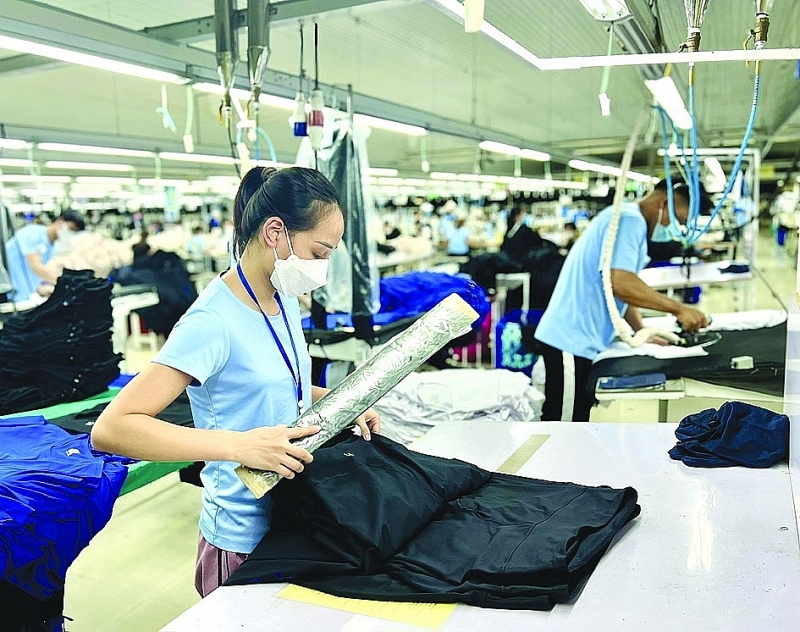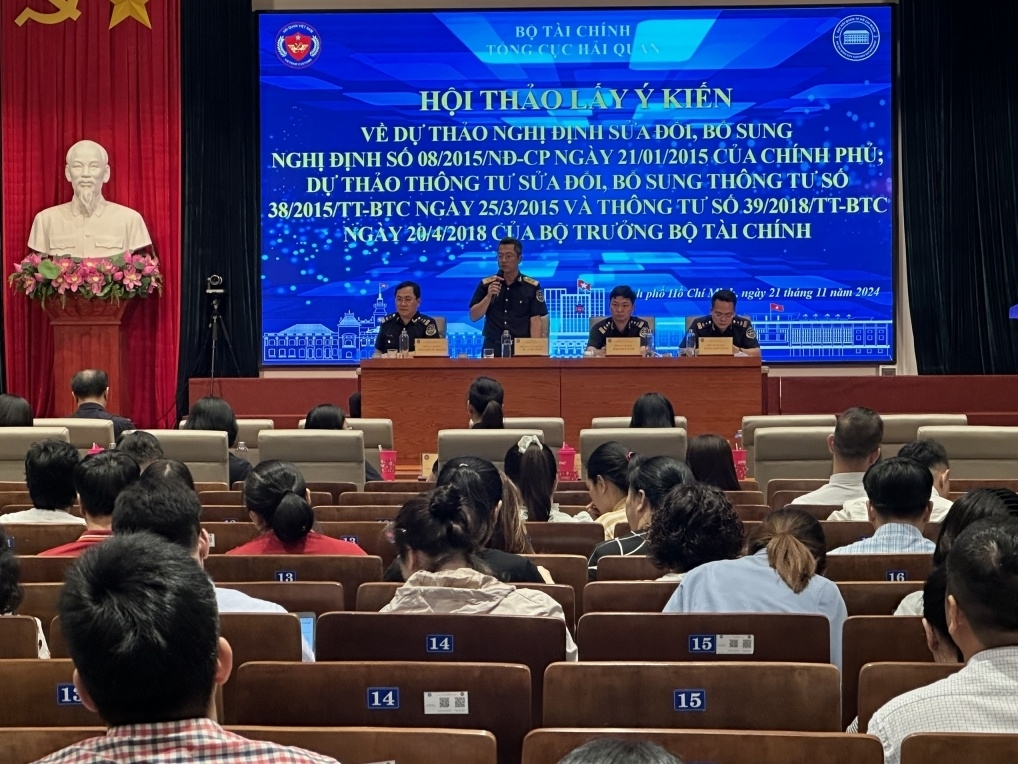Timely adapt to market fluctuations for sustainable export
 |
| The green policies of many markets with the textile and garment industry are considered more complex and challenging. Photo: H.Diu |
Many worries
At the recent trade promotion conference with the Vietnamese trade system abroad, Mr. Truong Van Cam, Vice President and General Secretary of the Vietnam Textile and Apparel Association, announced the first six months of the year. Textile and garment exports recorded positive growth, up about 5 percent compared to the same period last year. The main textile export markets are still the United States, the European Union (EU), Japan, South Korea, and China.
Vietnam's textile and garment industry has prospered because most major markets such as the United States and Europe have controlled inflation, helping to increase purchasing power. The amount of inventory in 2023 of brands has decreased, some textile and garment businesses have now gone through the association to find smaller companies to hire to reprocess orders. In addition, Vietnamese textile and garment enterprises have also proactively diversified markets and customers in recent times.
| A representative of the Vietnam Trade Office in Australia informed that, Australian market has very strict regulations and technical barriers, some of which are even higher than the US and EU. Australians focus on product quality with a notable tendency for consumer products to be evaluated based on "value for money" criteria rather than price criteria. Therefore, if they want to develop in the Australian market, Vietnamese export businesses need to give top priority to product quality. Besides, businesses need to make good use of incentives from FTAs, focusing on 3 FTAs in which Vietnam and Australia are both members. Participating in FTAs will create new opportunities, new industries and business fields, so businesses need to prepare to seize the opportunities. |
According to Mr. Cam, the industry's goal is to continue diversifying the market, not depending on certain markets; at the same time, diversify products to increase competitiveness. In order to achieve this goal, in addition to the main role of businesses, information from the system of Vietnamese trade agencies abroad plays an important role so that the industry can promptly grasp new market developments.
Currently, Vietnam's textile and garment industry not only faces competition from other export markets, but also faces standards and trade defense measures from import markets, Mr. Cam further informed and emphasized that major export markets such as the United States and EU have very strict regulations on greening and environmental protection. For example, in the United States, there is a law against forced labor; or the German Act on Corporate Due Diligence Obligations in Supply Chains and the European Supply Chain Due Diligence Act come into effect. This is a very practical warning for businesses.
In particular, the representative of the Vietnam Textile and Apparel Association said that recently, many large brands and retail groups are on the verge of bankruptcy or have filed for bankruptcy, a problem that has a major impact on businesses. Therefore, business warnings are very necessary so that businesses can avoid as much damage as possible.
Similarly, Ms. Phan Thi Thanh Xuan, Vice President and General Secretary of the Vietnam Leather - Footwear - Handbag Association also said that the leather and footwear industry also faces many challenges.
According to Ms. Xuan, in the first 6 months of the year, the export of the leather and footwear industry had many clear improvements. Export turnover reached 12.8 billion, an increase of more than 10 percent, it is expected that the whole year, the industry will reach a turnover of US$26-27 billion in 2024.
Regarding export markets, according to Ms. Xuan, India is a big market for the industry. However, exporting leather and footwear to this market still has many problems. Factories exporting to India are required to comply with direct control conditions at the factory and must be granted a certificate before they can export to this market. However, the licensing process encountered problems and took time. Therefore, the representative of the Vietnam Leather - Shoe - Handbag Association recommended that there should be close support from the business so that businesses can speed up this procedure.
Besides, Ms. Xuan also added that the leather and footwear industry is facing many big challenges. In the past, sustainable development activities were mainly proposed and encouraged by customers, but today they are legislated through policies issued by the governments of major footwear importing countries. Typically, the EU market has introduced a series of new policies on ecological products, or expanded responsibility for manufacturers, supply chain traceability, recycling, especially requirements for minimizing carbon emissions...
“All these regulations aim to increase quality and facilitate a circular economy in the industry. But these policies are affecting the entire supply chain, creating huge challenges for manufacturers, including Vietnam," Ms. Phan Thi Thanh Xuan shared.
To solve this problem, the representative of the Vietnam Leather - Footwear - Handbag Association said that the two textile and garment and footwear industries have proposed to the Ministry of Industry and Trade to establish and develop a trading center for raw materials and accessories in Vietnam. This will contribute to solving the problem of supply chain traceability, an important factor for successful exports.
Proactively adapt and take opportunities
From the perspective of trade agencies, the representative of the Vietnam Trade Office in the United States said that along with the development of trade turnover between the two countries, currently, the United States has many barriers for export businesses of Vietnam, typically trade defense measures through anti-dumping, anti-subsidy investigations and evasion of trade defense tax measures, as well as goods transportation. As of June 2024, the United States is the country that initiated the most trade defense investigations into Vietnamese exports, with 11 cases.
According to the Trade Office, the current general trend is that major markets, including the United States, continue to apply trade barriers on technology, hygiene, safety, environment, social responsibility... to protect domestic production and consumers, increasing compliance costs for businesses producing export products.
The representative of the Trade Office said that ministries need to continue to research and develop policies to encourage businesses to produce and export towards a circular economy approach, sustainable production and consumption factors with the purpose of gradually changing the production thinking of businesses, encouraging the application of technology, materials, and the use of renewable energy to be ready to meet standards and regulations in the US market.
Industry associations and businesses in related industries need to continue to develop towards specialization and modernization; improve product structure, focus on developing products with high added value; apply advanced quality management standards and regulations to enhance the industry's competitiveness; promote investment in the production of raw materials, auxiliary materials, supporting industries, and promote the localization process.
Related News

Over 300 Southern enterprises attend workshop to provide feedback to the General Department of Vietnam Customs
10:50 | 23/11/2024 Customs

Mid-November: Vietnam's trade volume matches 2023 total, eyes record-breaking growth
09:25 | 22/11/2024 Import-Export

Hanoi Customs resolves tax policy queries for enterprises
09:26 | 22/11/2024 Regulations

New export and business cooperation opportunities from "dual conversion"
10:53 | 23/11/2024 Import-Export
Latest News

US initiates investigation into pharmaceutical capsule shells imported from Việt Nam
17:50 | 23/11/2024 Import-Export

UKVFTA gives advantages to Vietnamese fishery products in the UK, urging focus on quality for further expansion
17:47 | 23/11/2024 Import-Export

Agricultural, forestry and fishery trade surplus value shoots up
10:54 | 23/11/2024 Import-Export

VN's food processing industry struggles to improve quality and value chain integration
15:53 | 22/11/2024 Import-Export
More News

Approach strategy of the seafood industry when implementing UKVFTA
09:26 | 22/11/2024 Import-Export

Vietnamese enterprises facing challenges from cross-border e-commerce platforms
14:32 | 21/11/2024 Import-Export

Vietnam, Malaysia eye new milestone in trade ties
14:29 | 21/11/2024 Import-Export
Shrimp exports surge in 10 months, generating 3.2 billion USD
14:27 | 21/11/2024 Import-Export

Vietnam’s exports to the U.S. near US$100 billion milestone
09:46 | 21/11/2024 Import-Export

From the “abnormal” coffee price, worries about the new crop
09:46 | 21/11/2024 Import-Export

What obstacles limit the market share of Vietnamese goods in the UK?
14:49 | 20/11/2024 Import-Export

Storm No. 3 destroys profits of many insurance companies
14:45 | 20/11/2024 Import-Export

Vietnam, Malaysia eye golden partnership opportunities in Halal industry
14:44 | 20/11/2024 Import-Export
Your care

US initiates investigation into pharmaceutical capsule shells imported from Việt Nam
17:50 | 23/11/2024 Import-Export

UKVFTA gives advantages to Vietnamese fishery products in the UK, urging focus on quality for further expansion
17:47 | 23/11/2024 Import-Export

Agricultural, forestry and fishery trade surplus value shoots up
10:54 | 23/11/2024 Import-Export

New export and business cooperation opportunities from "dual conversion"
10:53 | 23/11/2024 Import-Export

VN's food processing industry struggles to improve quality and value chain integration
15:53 | 22/11/2024 Import-Export





